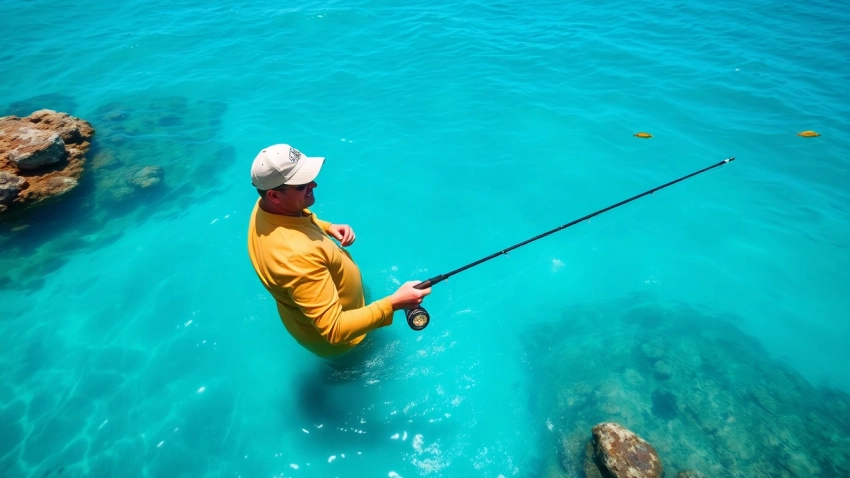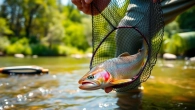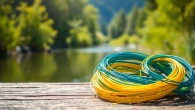
Mastering Saltwater Fly Fishing: Techniques, Gear, and Best Practices
Understanding Saltwater Fly Fishing Basics
Saltwater fly fishing is an exhilarating activity that blends the art of fly fishing with the unique challenges and rewards presented by saltwater environments. Unlike freshwater fishing, where one often encounters rivers and lakes with predictable conditions, saltwater fishing is inherently dynamic. It calls for a deeper understanding of various environmental factors, fish behaviors, and specialized gear that can withstand the corrosive nature of saltwater. This comprehensive guide aims to delve into the fundamentals of Saltwater fly fishing, providing useful insights for both newcomers and seasoned anglers alike.
What is Saltwater Fly Fishing?
Saltwater fly fishing involves using a fly rod, reel, and artificial flies to catch fish in oceanic and brackish waters. The primary allure lies in targeting species that are often larger and more challenging than their freshwater counterparts, making the experience both rewarding and demanding. The practice generally occurs in coastal regions, estuaries, and offshore locations, where the ecosystem supports a diversity of marine life.
This form of fishing emphasizes technique over sheer strength, requiring anglers to cast delicate flies that mimic the natural prey of saltwater fish. Typical targets may include species such as tarpon, bonefish, redfish, and permit, each demanding specific techniques and approaches to successfully entice them.
Common Species Targeted in Saltwater Fly Fishing
Saltwater fly fishing showcases a broad spectrum of species that attract anglers from all corners of the globe. Here are some of the most sought-after species:
- Bonefish: Known for their challenging fight, bonefish inhabit shallow waters and are most active during warm months.
- Tarpon: Often referred to as “silver kings,” tarpon are renowned for their acrobatic displays and can grow to impressive sizes.
- Permit: One of the most challenging species to catch on fly due to their skittish nature, targeting permit is a rite of passage for many saltwater fly anglers.
- Redfish: A favorite among many anglers, redfish are generally more forgiving but still provide a solid challenge due to their size and strength.
- Striped Bass: Common in various saltwater habitats, striped bass are both plentiful and aggressive, making them an exciting target.
Essential Gear for Beginners in Saltwater Fly Fishing
Equipping oneself with the appropriate gear is pivotal for a successful day on the water. For novices, the foundational items include:
- Fly Rod: A good rod typically ranges from 8 to 12 feet in length, with a medium to fast action to handle larger species and windy conditions.
- Fly Reel: Choose a durable reel designed for saltwater conditions, featuring a smooth drag system to handle the fight from larger fish.
- Fly Line: Floating or sinking lines designed specifically for saltwater will ensure your flies reach the desired depth.
- Leader and Tippet Material: Use strong and abrasion-resistant fluorocarbon leader lines, typically ranging from 20 to 50 pounds.
- Flies: Invest in a selection of patterns that mimic local baitfish and invertebrates suitable for your target species.
Techniques for Successful Saltwater Fly Fishing
Success in saltwater fly fishing revolves around mastering casting techniques, understanding the tides, and using the right flies. Each element plays a crucial role in how effectively you can target and land fish.
Effective Casting Techniques for Saltwater Fly Fishing
Effective casting in saltwater fly fishing is essential for reaching fish located far from shore or in challenging environments. Here are some techniques to master:
- Double Haul Casting: This technique allows for longer casts by using a two-part haul during the backcast and forward cast, enhancing line speed and distance.
- Accuracy: Precision is vital, especially when targeting spooky fish in shallow waters. Practice distance and targeting skills on the water or at casting clinics.
- Timing: Proper timing in your casting motion can dramatically improve not only distance but also the ability to present the fly naturally.
Reading Tides and Currents in Saltwater Fly Fishing
Understanding tides and currents is critical. Fish behavior often correlates with these movements. Here’s how to navigate this aspect:
- High and Low Tides: Fish tend to feed actively during incoming and outgoing tides, so timing your fishing sessions can significantly affect your success.
- Current Patterns: Look for eddies, rips, and points where current flows; these are hotspots for fish congregating to ambush baitfish.
- Wind Direction: Wind can affect the tide, and understanding how wind interacts with water movement can help direct your casting efforts.
Using the Right Flies for Different Conditions in Saltwater Fly Fishing
Selecting appropriate flies for varying conditions can define the success of your trip. Factors to consider include:
- Water Clarity: In clear waters, use smaller, more natural-looking flies; in murky conditions, larger, more vibrant options may be necessary to attract fish.
- Species-Specific Patterns: Some flies are closely associated with specific species, so research local favorites, such as crab patterns for permit or baitfish imitations for tarpon.
- Seasonal Changes: Adapt your fly selection according to seasonal patterns—certain species may be more accessible at various times throughout the year.
Gear Selection for Saltwater Fly Fishing
Selecting the right gear is critical for ensuring durability and effectiveness in saltwater environments. Below are essential components to focus on:
Choosing the Right Fly Rod for Saltwater Fly Fishing
When selecting a fly rod for saltwater fishing, consider the following:
- Weight: Rod weights typically range from 8 to 12, depending on the species being targeted. Heavier rods are necessary for larger game fish.
- Material: Graphite rods provide the best performance, offering strong yet lightweight options suitable for long days on the water.
- Length: Longer rods enable better casting distance and line control in windy conditions.
Importance of Leader and Tippet Material in Saltwater Fly Fishing
The choice of leader and tippet material plays a pivotal role in effective fishing:
- Fluorocarbon vs. Monofilament: Fluorocarbon is often preferred due to its lower visibility in the water and greater abrasion resistance against sharp structures.
- Breaking Strength: Ensure your leader and tippet can withstand the strikes and fights of strong saltwater species without snapping.
- Length of Leader: Longer leaders can help provide a more natural presentation, especially in clear water.
Best Reels for Saltwater Fly Fishing Environments
Investing in the right reel is crucial for both performance and longevity in saltwater conditions:
- Corrosion Resistance: Choose reels made from corrosion-resistant materials, such as anodized aluminum, which can withstand saltwater exposure.
- Drag System: A durable, smooth drag system is vital to tire out larger fish and prevent line breakage during the fight.
- Weight Distribution: Ensure that the reel is balanced with your rod for comfortable and efficient fishing.
Popular Saltwater Fly Fishing Destinations
Exploring the right destinations enhances the saltwater fly fishing experience. Here are some top locations known for producing abundant catches and breathtaking views:
Best Coastal Locations for Saltwater Fly Fishing
Different coastal areas cater to various targeted species, creating unique fishing experiences. Some renowned spots include:
- Florida Keys: This area is hailed as one of the premier saltwater fly fishing destinations globally, attracting anglers with its extensive flats and diverse species.
- Outer Banks, North Carolina: Home to some of the biggest redfish and striped bass runs, Outer Banks is ideal for those seeking adventure and quantity.
- Montauk, New York: Known for its amazing fall run of striped bass, Montauk offers dramatic landscapes and considerable fishing opportunities.
- Palm Springs, California: Great for targeting coastal halibut and other game fish, this area adds diversity to the saltwater fly fishing repertoire.
Planning a Saltwater Fly Fishing Trip: What to Consider
When planning your ultimate fishing escape, consider the following factors to ensure a fruitful trip:
- Seasonality: Different locations have peak fishing seasons for various species; plan accordingly to maximize your catch potential.
- Local Guides: Hiring a local fishing guide familiar with the area can save time and provide insights that enhance your fishing experience.
- Weather Conditions: Always check weather forecasts, as storms and winds can affect fishing conditions and safety on the water.
Local Regulations and Conservation Efforts in Saltwater Fly Fishing
Understanding and adhering to local regulations ensures sustainability and conservation of marine life. Key considerations include:
- Licensing: Ensure that you have appropriate fishing licenses required in the areas you plan to fish.
- Catch Limits: Familiarize yourself with local regulations regarding catch limits for different species to help preserve fish populations.
- Conservation Practices: Practice catch-and-release techniques where appropriate to contribute positively to the ecosystem.
Advanced Tips and Tricks for Saltwater Fly Fishing
As you gain experience, delve into advanced techniques that can elevate your saltwater fly fishing game and boost your success rate.
How to Improve Your Casting Distance for Saltwater Fly Fishing
Optimizing your casting distance can make a significant difference, particularly in vast saltwater environments. Consider the following tips:
- Practice: Regular practice is essential, focusing on both distance and accuracy. Set up specific drills to enhance your casting technique.
- Use Backcasting Space: Having ample backcasting room can significantly improve your distance; ensure you’re aware of your surroundings.
- Relaxed Grip: A light grip on the rod can contribute to smoother casts and prevent excess wrist movement, which often restricts distance.
Secrets to Stealth in Saltwater Fly Fishing
Fish in saltwater often spook easily, especially in shallow areas. Improving your stealth techniques can lead to higher success rates:
- Approach Slowly: Always approach fishing spots quietly and avoid splashing or sudden movements that may alert fish.
- Use Natural Cover: Stay hidden behind rocks, vegetation, or other natural structures while casting to avoid detection.
- Mind Your Shadow: Avoid casting shadows over fishing zones, as fish may become intimidated and retreat.
Navigating Tricky Weather Conditions in Saltwater Fly Fishing
Weather can be unpredictable, and knowing how to navigate these conditions is crucial:
- Wind: While light winds can be beneficial, strong winds require adjustments in casting technique and tactics.
- Rain and Storms: Rain can alter fish behavior; often, fish are more active in the hours preceding and following a storm.
- Temperature Changes: Be aware of water temperature changes, as fish are more likely to be active within optimal temperature ranges.









Leave a Reply